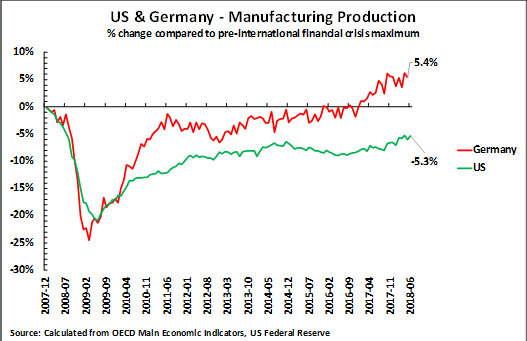Major Power Relations
Your Present Location: PROGRAMS> Major Power RelationsJohn Ross: Why Germany's success in manufacturing is important to China
By John Ross Source: CGTN Published: 2018-9-16
In my previous piece, I argued that US manufacturing has failed to regain its previous pre-international financial crisis levels after analyzing its manufacturing output and employment data. Its failure contrasts sharply with the situation not only of China but also of Germany. To illustrate this, the latest data for German manufacturing production is for June 2018.
The following figure shows that in that month where US manufacturing production was 5.3% below its pre-financial crisis peak, German manufacturing production was 5.4% above it. In other words, while there had been no expansion of US manufacturing production, compared to levels achieved 11 years previously, in Germany there had been a significant expansion of manufacturing output.

US per capita GDP growth lost to Germany
This contrast of the trends in US and German manufacturing production may, in turn, be analyzed in relation to the comparative trends in US and German per capita GDP. This latter issue is of particular relevance to China because it is well known that China faces slow population growth due to the legacy of the one-child policy, and while adoption of the two-child policy may ameliorate this, it is unlikely to dramatically reverse this trend.
China's demographic reality, among its other consequences, therefore necessarily means that the key to China's economic performance is per capita economic development rather than simply total GDP growth.
In this regard it is insufficiently noted in China that the US lead among advanced economies in GDP growth is based on its rapid expansion in population – itself created both by the US domestic birth rate and relatively relaxed immigration laws. From 2000 to 2017 US population increased by 15.4% – higher than any other G7 country except Canada.
For comparison, China's population growth in the same period was only 9.7%. The lowest population growth rate in any G7 economy during the 21st century was in Germany – with only a 1.5% total population increase.
In terms of per capita GDP growth, Germany held the first position, with a total increase in per capita GDP in 2000-2017 of 22.0% compared to 17.9% for the US.
In short, the US lead over Germany in terms of GDP growth was due to the US having a more rapid population growth than Germany. In terms of per capita increase in production, the measure of particular importance to China, Germany outperformed the US. This was correlated with German manufacturing production outperforming US manufacturing production as analyzed above.
Germany's success is of particular importance to China
This fact that Germany's rise in per capita GDP, which is necessarily reflected in competitive performance, has significantly outperformed the US during the 21st century has major global economic and geopolitical consequences.
In particular, it is shown in the increasing German balance of payments surplus – an index of its strengthening international competitive position. By 2017, Germany's current account balance of payments surplus had become the world's largest at 297 billion US dollars. In contrast, the US ran a current account deficit of $466 billion. China and Japan also ran surpluses, but less than Germany's, at $165 billion and $195 billion respectively.
In summary, in order to understand both the global economic and geopolitical situation, it is necessary to thoroughly reject the myth that there was in the last period a successful expansion of US manufacturing. A situation where US manufacturing output remains at a lower level than 11 years ago entirely refutes that analysis.
John Ross is a senior fellow at Chongyang Institute for Financial Studies at Renmin University of China.























































































 京公网安备 11010802037854号
京公网安备 11010802037854号





